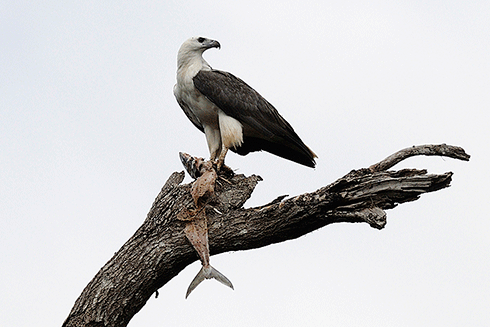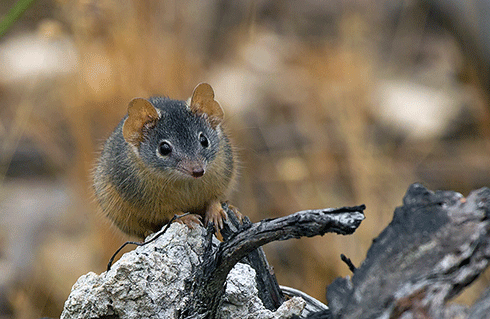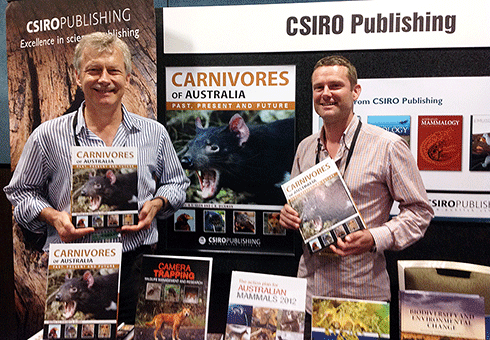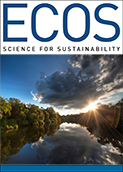
|
Published: 15 December 2014
How flesh-eaters helped shape our ecosystems
Australian carnivores exhibit a remarkable diversity, from the small antechinuses found in rainforest trees, to goannas living in the heat of the central and western deserts. Each plays a vital role in our ecosystems, keeping other predators and herbivores under check and exerting ecological pressure from the top down.

|
|
A white-bellied sea-eagle with prey, Mission Beach, Queensland Credit:
John Manger
|
A new book, Carnivores of Australia: Past, Present and Future – published by CSIRO Publishing and edited by ecologists Dr Alistair Glen and Professor Chris Dickman – focuses on the ecological importance of our carnivores. The book brings together Australian and international scientists to explore the state of our knowledge about Australian predators, past and present. ECOS writer Beth Askham recently caught up with Chris to discuss the book.
What was your vision for the book?
We wanted to make sure all Australian predators were covered. Reptilian carnivores are often overlooked, for example, even though Australia has a wonderfully diverse fauna including goannas and salt water crocodiles.
Birds are often overlooked as well. We initially wanted a bird on the cover – to make the point that it’s not all about mammals. But the photogenic Tasmanian devil won out!
Another motivation for the book is our increasing awareness that top carnivores are disappearing. As they disappear, there are unwanted effects on ecosystems.
We are just beginning to appreciate how important predators are. A study from America showed if you take out the sharks from an ecosystem, you get increases in prey such as bullnose rays that then eat all the molluscs, and the whole ecosystem collapses.
The other effect that big predators have is on herbivores – take [the predators] away and you get an increase in herbivores and this in turn impacts on the plants. This is why the world is green – it’s because we have the predators. If we didn’t have them, herbivores would decimate the plants.
How do larger predators influence ecosystem dynamics?
There are two groups kept in check by larger predators – smaller predators and herbivores.
The herbivores are either eaten or scared by the larger predators and frightened away. The big carnivores will sometimes kill the smaller carnivores but they don’t necessarily eat them.
For example, dingoes hunt foxes and cats but they will not eat them. There is a really fascinating study from South Australia that took place inside a 37-square-kilometre enclosure. With just two dingoes inside, workers placed six foxes and seven cats in the same enclosure. Within a few days, all the foxes and at least three of the cats were found and killed by the dingoes.
Because all the animals had GPS collars, the researchers knew where and when the attacks took place – they know that a dingo was at the ‘scene of the crime’. They also retrieved the carcasses to show they had been chewed by a dingo. Interestingly, the dingo would leave the carcass and then go back to it every so often – maybe to make sure they were really dead!

|
|
A yellow-footed antechinus, also known as the mardo. Credit:
Patrick_K59 CC BY-NC-SA 2.0
|
Can the impacts of predators on ecosystems be positive as well as negative?
It depends on the predators – we have a good understanding of the impacts of foxes and cats, and they are very negative. They can keep down rabbits, primarily in agricultural and pastoral areas, but are detrimental to wildlife. If foxes and cats increase in activity, you lose many of the smaller predators.
For the dasyurids predators, we don’t have a great handle on what they do – we have some evidence that they impact invertebrates. The small eastern quoll eats pasture grubs for example – such as army grubs – but whether they affect populations of these pests is unclear.
Larger quolls tend to eat small wallabies and gliders. The little guys, like eastern and western quolls, tend to be insectivores.
In terms of humans and predators generally, we haven’t really found a way to interact with predators. In some cases, we are encroaching on their land and the big predators will kill livestock and sometimes humans. This will become more of a challenge as human impacts on habitat increase.
Can you tell us a little about the predators of Australia’s past? I was interested to read in your book about the ‘demon duck of doom’!
There were some really big and fierce carnivores that used to stalk the continent. The most impressive mammal was the marsupial lion that was well over 100 kilos in size – they would have been full-on carnivores. They existed at a time when there were very large birds and lizards too.
One of the biggest lizards in Australia’s past was a creature called Varanus prisca. It’s the same genus as the present day goanna, but it was super-sized. We can be pretty confident that these ancient predators were carnivorous, but it’s harder to tell whether they hunted their prey or if they scavenged.
It’s often been said that Australia lacked mammalian carnivores and this is why the fox and cat have had a particularly devastating effect, but this is not true: there have been many fearsome mammalian carnivores in Australia’s past.
You wrote a chapter in the book on dasyurids. What’s the most interesting thing about these ‘micro’ carnivores?
There is no part of the continent where dasyurids are not found. In terms of their biology they are just fascinating. But what’s most interesting is their reproduction. Antechinus males all die within a week of the mating period. Phascogales do the same. Some populations of the northern quoll die off after mating as well. There are probably five genera in which this phenomenon is known.

|
|
Chris Dickman and Alistair Glen with their new book, Carnivores of Australia. Credit:
Melinda Chandler, CSIRO Publishing
|



